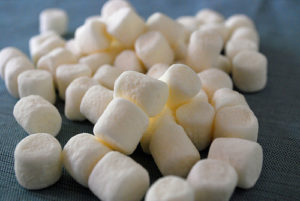Photo credit: http://www.flickr.com/photos/sliceofchic/4941627622/
The Famous Marshmallow Test
Recently I had the pleasure of speaking to the parents of Westcot Elementary and Inglewood Parent Participation Pre-School on the topic of Self-Regulation. In the last 3-4 years Self-Regulation has become a real buzz word although the concept has been around for a long time. Back in the 1960’s the famous “Marshmallow Test” was conducted by Dr. Walter Mischel of Stanford University. In this delightful 3 minute video you will see young children wrestle with the mental challenge of resisting or trying to resist eating a marshmallow that is placed in front of them, with the instructions that they will receive a second one if they can control the temptation to eat the first one until they are allowed. This long term study showed that the children who had shown the ability to wait got better grades, and as adults were healthier, enjoyed greater professional success, and proved better at staying in relationships. The idea of “success” became less about IQ and more about EQ – emotional intelligence.
How Does One Define Self-Regulation?
Dr. Stuart Shanker, Professor at York University, Ontario, Canada has become one of Canada’s leading experts on self-regulation. I have seen him speak twice in Vancouver and I really appreciate his approach and knowledge. In his book, Calm, Alert and Learning, he defines self-regulation as: “The ability to monitor and modify emotions, to focus or shift attention, to control impulses, to tolerate frustration or delay gratification.” A more comprehensive definition that he presents from the work of Baumeister & Vohs (2011) is:
1. Attain, maintain and change one’s level of energy to match the demands of a task or situation
2. Monitor, evaluate and modify one’s emotions
3. Sustain and shift one’s attention when necessary and ignore distractions
4. Understand both the meaning of a variety of social interactions and how to engage them in a sustained way
5. Connect with and care about what others are thinking and feeling – to empathize and act accordingly
Recognizing the Different Zones of Self-Regulation
The first step to self-regulating is creating awareness and recognizing where we are on a scale. There are many programs available that teach children (and adults) how to recognize where we are on a scale. My favourite program is called The Zones of Regulation by Occupational Therapist, Leah Kuypers. I have seen her program implemented as a school-wide program (at Westcot Elementary) where every classroom from Kindergarten to Grade 7 uses the common language. The colours are very clear and easy to understand and they tie into traffic signs and traffic lights. Red (stop) = the most heightened state (angry, out of control, terrified etc.) Yellow (slow down) = an agitated state (worried, upset, silly etc.) Green (go) = calm, relaxed, happy, calm etc. and Blue (I think of sea level) = low energy states such as sadness (“feeling blue”, sick, injured, sleepy, bored etc.). Once the students are familiar with the zones, they learn the strategies to help them stay in the “green zone” or get back to the “green zone”. I also use this program in my counselling sessions and in my groups for children with anxiety and self-empowerment groups for children.
The Five Domains of Self-Regulation
According to Stuart Shanker there are five domains to be aware of when we think of self-regulation:
1. The Biological Domain: this is the activity or level of energy in the human nervous system. This is when we look to see if a child needs “down-regulating” or “up-regulating”. Occupational Therapists have specialized training in this area and may suggest a fidget toy for a child who needs to fidget to be able to listen better! What a shift in thinking from the old mind-set of “sit still and pay attention”. Other children may need a wobble disc to rock on as they work and others may need a quiet corner in the classroom where they can get relief from all the external stimulation.
2. The Emotional Domain: this is the energy around feelings and moods. The more a child is feeling calm, happy and safe the more curious, interested and confident the child will be as a learner. The more stressed, angry, frustrated, anxious, ashamed etc. children feel, the more difficulty they will have concentrating.
3. The Cognitive Domain: these are the mental processes such as memory and attention, ability to problem-solve and remember information.
4. The Social Domain: the understanding and assessment of social cues
5. The Prosocial Domain: behaviours that are helpful and friendly toward others
For more information on self-regulation and these five domains see Stuart Shanker’s excellent website: www.self-regulation.ca
I hope you have a wonderful week, hopefully in the “green zone”!
Warmly,
My 6 Top Apps for Creating More Calm for You and Your Children!
Want to Connect?
Subscribe now to receive free weekly parenting tips and inspiration.








